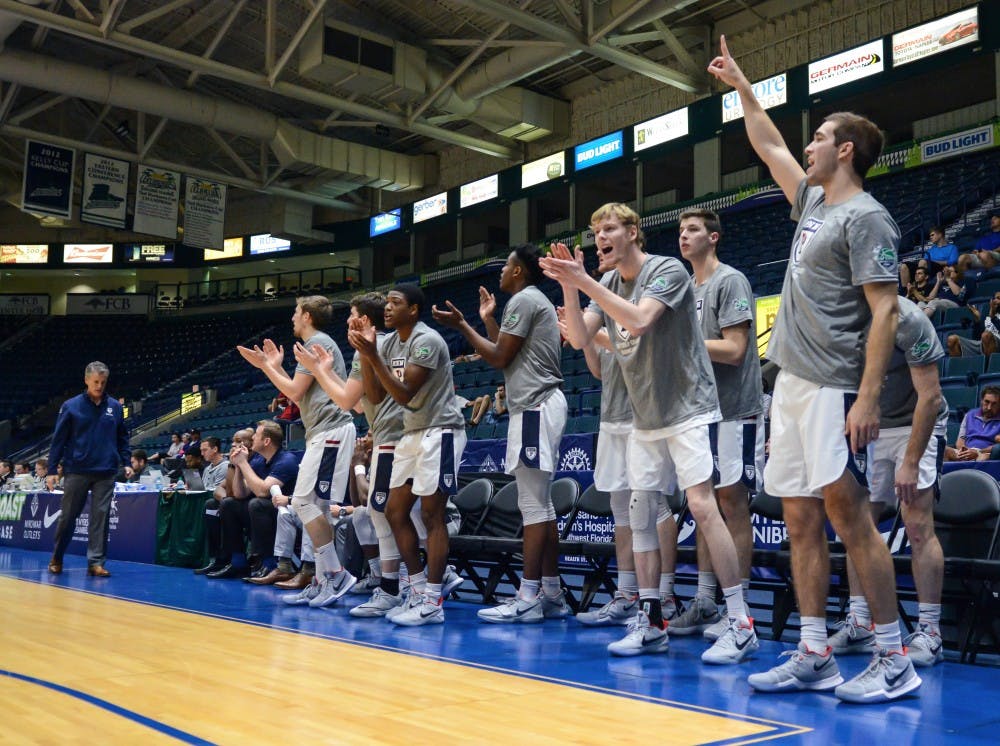
Penn men's basketball has seen more good than bad thus far this season, and the team is the top-ranked squad in the Ivy League in terms of RPI
Credit: Zach SheldonThe last time Penn men’s basketball started a season with a 7-4 record in its first 11 games, the team went 14-0 in the Ivy League and made it to the NCAA Tournament. That was 15 years ago.
To think the Quakers are well on their way to another euphoric season reminiscent of the Fran Dunphy days is putting the cart before the horse, but there are several indicators as we approach the end of their ‘preseason,’ so to speak, that are cause for serious optimism.
First, the team is scoring more. Way more. Averaging almost 78 points a game, Penn has put up 9.6 more points per game than through the same stretch last season, and 10 more than the year before that. Save for their 99-point effort against PSU Brandywine, it’s not like the Quakers’ strength of schedule is significantly weaker this time around, as they found themselves just this past weekend ranked 92nd in the Rating Percentage Index (RPI).
What’s more is that the increase in scoring has come from all over the floor. Sophomores Ryan Betley and AJ Brodeur have averaged 15.0 and 11.3 points per game, respectively, while senior captain Darnell Foreman has put up a clean 10.0 to give the Quakers three double-digit scorers. Meanwhile, senior Caleb Wood and junior Jackson Donahue have brought serious shooting power off the bench, registering 8.8 and 5.1 points on average.
Often the Quakers start games out attacking the rim down low — this was clearly seen at Lafayette, when Brodeur scored his team’s first 10 points. But when Brodeur and fellow big man Max Rothschild are double-teamed or shut down, they can kick the ball out knowing there are shooters waiting in the wing. Anyone on the team can score, giving opponents a problem that coach Steve Donahue was happy to point out after beating Lafayette: there are too many players to account for in opponents’ gameplans.
In the four-overtime win at Monmouth, it was rookie Eddie Scott, with his 21 points, including two huge double-obertime dunks and a perfect percentage from the field, who was the hero. But Scott can’t even break his way into the top of the rotation with his 52 percent shooting this season. Nor can classmate Jarrod Simmons, shooting 50 percent from the field thus far in impressive performances.
That’s how much firepower this team has.
But the starting five has been so consistent that Donahue hasn’t needed to experiment like he did in the first half of last season. Foreman, Woods, Betley, Brodeur, Rothschild — the same five names have begun each game this season.
They may not need to do all the scoring, but as Donahue has noted, they provide the consistent grit and leadership the Quakers have needed to move past the fringe Ivy tournament qualifiers they were last season and into the established tournament contenders they are today.
Penn is winning every game it’s supposed to, with perhaps its season opener at Fairfield the exception. The impressive part about this is that the team hasn’t even been at its best in several of these contests — against UMKC, Howard, and Lafayette, the Quakers had long stretches of poor shooting, but managed to score enough to win all three anyway.
When they do shoot well, the numbers they put up are unreal. 93, 99 (admittedly against a non-NCAA team), and 101 (admittedly in a sixty-minute game) points have given the team highlight reel nights it could have only dreamed of through 11 games last year.
Finally, an important contextual factor to take note of is that the rest of the Ivy League is performing below expectations so far this season. Only Yale has won more than half of its games with a 6-5 record, but none of its wins could be labelled ‘signature,’ by any means. The Bulldogs also face the loss of key players Makai Mason and Jordan Bruner to injury.
Reigning Ivy League champion Princeton is 2-6, with its two wins coming over Lafayette and Fairleigh Dickson, ranked No. 323 in the RPI.
Harvard is generally thought to be the only other team capable of winning the league. At 4-6 after a tough schedule, the Crimson has struggled but held its own. The jury is still out on whether Harvard, which has been hurt by both injuries and a bizarre food poisoning case, can gel together before Ivy League play starts.
Penn is gelling. The Quakers are there, with their best start in 15 years showing how they could finally make their way back to the top of the Ancient Eight in 2018.
There’s still more than a lot of basketball to be played, but based on a sample of 11 games, Penn men’s basketball looks better than ever in recent memory, and possibly better than any other team in the league.
The Daily Pennsylvanian is an independent, student-run newspaper. Please consider making a donation to support the coverage that shapes the University. Your generosity ensures a future of strong journalism at Penn.
Donate







